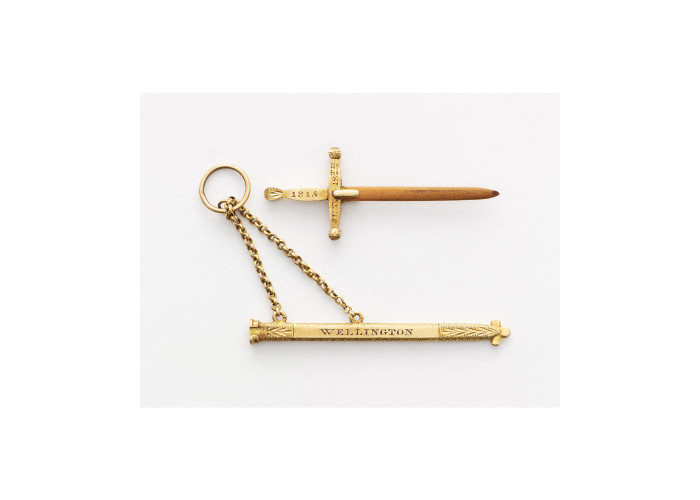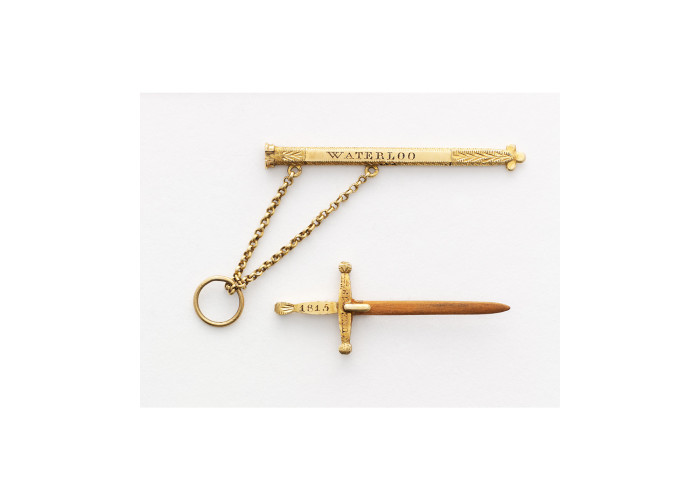Commemorative Miniature Wooden Sword
This tiny model sword, less than 5cm long, is made from gold and a sliver of wood from the battlefield of Waterloo. An adornment for a fashionable lady, it was hung from a long chain or sautoir, or from a woman’s waist.
For much of the early stages of the Battle of Waterloo, Wellington directed the operations of his army from a command post sited next to an elm tree that stood by the crossroads where the Ohain Road crossed the main Charleroi-Brussels highway. Because of its connections, this tree became a symbol of the battle itself, being commemorated in art and poetry.
Pieces of the tree were hacked off by those seeking battlefield mementoes, and its remains were eventually cut down so that the wood could be fashioned into more sophisticated souvenirs. Chairs were made from some of the larger pieces of timber, whilst smaller pieces of wood were fashioned into more delicate keepsakes.
In the case of this sword, it is the blade that is made from salvaged elm-wood, with the scabbard, decoration, and chain all being fashioned from gold. The words “Wellington” and “Waterloo” are carved on either side of the tiny scabbard, while the cross-bar bears the date of the battle, 18 June 1815. The sword, with its straight blade and the cross-guards set at right angles to give a crucifix shape, owes more to medieval styles than to any attempt to copy the sort of swords that would have been used at Waterloo.
The sword is believed to have been the property of Field Marshal Lord Raglan, who commanded the British forces in the Crimean War (1854-56). Born Fitzroy Somerset, the future field marshal was the youngest son of the 5th Duke of Beaufort and had begun his military career in 1804 at the age of only 15. Young Somerset was well-connected, and served in a series of staff appointments. He joined the staff of the future Duke of Wellington, then Lieutenant General Sir Arthur Wellesley, in 1808. Somerset served with Wellington throughout the Peninsular War (1808-14), eventually as Military Secretary.
He joined him in the same capacity for the Waterloo campaign, by which time he had risen to the rank of lieutenant colonel and had received a knighthood. (He was not raised to the peerage until 1852.) At Waterloo, Somerset was wounded in the right arm, which had to be amputated. Famously, after the operation was complete, he asked for the severed limb to be returned to him so that he could retrieve a ring from his right hand.
It might be thought that Somerset would have had no wish to be reminded of the day he lost his arm, but as a staunch admirer of Wellington he was clearly as keen as anyone to obtain a souvenir of the battle.
It is very possible that the model sword was presented to Wellington’s niece, Lady Emily Wellesley-Pole (1792-1881), who married Somerset, later Lord Raglan, in 1814.
-
Education overview
Sources
National Army Museum page on Raglan’s sword: http://www.nam.ac.uk/online-collection/detail.php?q=searchType%3Dsimple%26acc%3D2014-05-8&pos=0&total=1&page=1&acc=2014-05-8-1
George Crabbe’s poem about the Waterloo Elm: http://www.bartleby.com/270/6/262.html
-
Curatorial info
- Originating Museum: National Army Museum
- Accession Number: NAM. 2014-05-8-1
- Production Date: c. 1818
- Material: Gold, elm wood
- Size: 48mm long x 15 mm wide x 2mm deep. Hilt 8mm wide.
- Original record
-
Use this image
You can download and use the high resolution image under a Creative Commons licence, for all non-commercial purposes, provided you attribute the copyright holder.
- Rights Holder: Copyright National Army Museum. Photography Relic Imaging Ltd.
- License Type: Creative Commons
Find it here
This object is in the collection of National Army Museum













